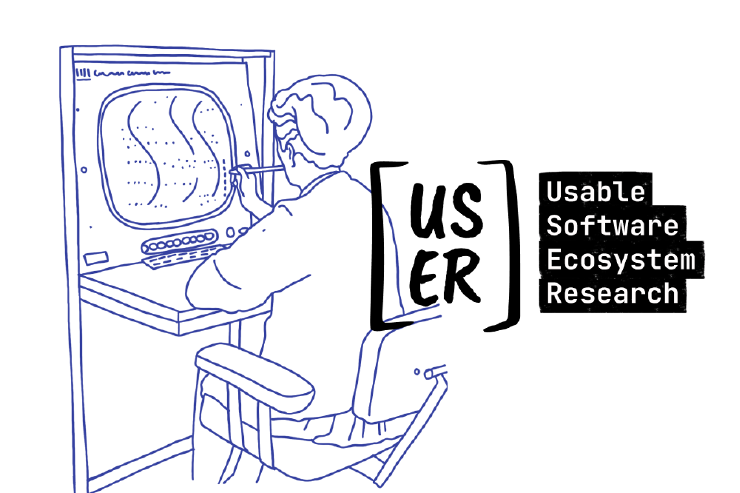
Usable Software Ecosystem Research (USER) is a Sloan Foundation-supported research initiative that explores how open source scientific and research software (SROSS) teams understand, consider, and undertake usability and design opportunities in their projects. To read more about this project please check out Blog #1, Blog #2, our project website, and open repo.
Wrapping up a world of insights
In the last 6+ months, our team completed 27 interviews, two community surveys and attended nearly 10 conferences and convenings related to the USER project and its line of inquiry. Since February, our six-person research team has collaborated virtually and in-person to analyze the huge amount of qualitative and quantitative data we’ve collected over the course of this project. USER illuminated countless insights, from a close look into how a diverse set of Science and Research Open Source Software (SROSS) projects and their contributors consider their users to how they approach the usability and broader design aspects of their projects, to the complex and often contradictory ways in which they understand and build SROSS tools.
Our complete findings can be found on our newly published project website and in our public repository on GitHub. We’ve selected excerpts from a few key findings and recommendations to give a taste of what this research surfaced:
Finding: SROSS projects and the designers working on them are engaging in deeply cross-disciplinary work that requires the cultivation of language and mutual respect amongst collaborators
If you’re curious to learn more, read our Executive Summary and complete in-depth findings on our project website.
SROSS development often needs cross-disciplinary work. This can be challenging as norms and common language need to be negotiated between different work cultures. In SROSS projects, there is often a disciplinary exchange between programmers and scientists. Add designers, and there is a third ‘language’ and working style. Effective cross-disciplinary collaboration ranges in strategy and process. Some projects prioritize mutual understanding and a state of continuous knowledge transfer between disciplines, while others take a more synergistic approach where each expert is able to excel in their domain without the burden of needing to know the ‘other’ discipline well. Regardless of the approach, mutual respect, communication and knowing the value of each role’s contribution is vital to the success of design and usability in SROSS.
Finding: Implementation of design practices is aspirational but inconsistent across projects
Whether projects establish design and usability practices depends on the perceived utility of design work; what non-designers define as design, usability, and accessibility; and the ease of implementing design changes. If design work is seen as time intensive, disruptive, requiring code overhaul, and/or frivolous, the implementation of design practices is unlikely. Even when design and usability are valued, many see it as optional, incidental, or aspirational. In this case, design implementation is only ‘worth it’ when it is clearly linked to the expansion of a user base. We observed this most potently in projects with diverse users. SROSS projects express that they want to improve tools and services. Dedicated design and usability work could help doing this, but SROSS projects do not often realize this. Good design and usability practices empower users, make tools easier to use, and require less immediate support from maintainers, which ultimately helps fulfil the purpose of research and scientific discovery.
Based on our findings, we developed recommendations for SROSS projects
Here are three of our recommendations. To read all of our recommendations, see our project website
Promote design and usability as a practice that cuts labor and time for maintainers.
Usability improvements can reduce the time that maintainers, developers and community contributors spend writing step-by-step user guides and answering customer support requests when users are having difficulties with the tool.
Make the entry points to contribution beyond code clear and inclusive.
Clear contribution paths and entry points allow potential contributors to understand where they are needed and how they can be most useful.
Inclusivity increases contributions, because designers and other non-code contributors will see their work as valued and prioritized.
Develop resources, community spaces, shared channels, and information repositories for SROSS design.
If OSS/SROSS designers share experiences and learn from each other, they can help shape best practices and reduce barriers for designers new to the ecosystem. Also, including designers in OSS/SROSS maintainer channels, and vice-versa, will help increase designer/developer collaboration and provide guidance to projects without a designer on the team. Institutions can support this by promoting reuse of science and research and usability.
*
In closing, we invite you to read our Executive Summary and complete in-depth findings on our project website.
Credits
Project Contributors: Eriol Fox, Jan Dittrich, Ngọc Triệu, Abhishek Sharma, Katie Wilson, Susan Kennedy, Georgia Bullen.
With support from the Alfred P. Sloan Foundation.